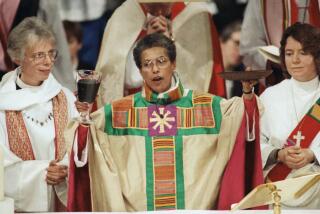What would Mary do?
- Share via
According to the New Testament, women were among the earliest followers of Jesus and played an important role in early Christian communities. Even today, the “man in the pew” is likely to be a woman. But women in many Christian denominations continue to complain that they have been unable to break through what is sometimes called the stained-glass ceiling. Obviously, theology plays a part in this phenomenon, but so does the conviction -- found among believers and nonbelievers alike -- that this is a man’s world.
Last month, the Vatican informed the Rev. Roy Bourgeois, a Georgia priest and political activist, that he faced excommunication if he didn’t repudiate his participation in the unauthorized ordination of Janice Sevre-Duszynska. The reprimand for Bourgeois was not a surprise given pronouncements by Pope John Paul II and Pope Benedict XVI, but it dramatized the hardening of the Vatican’s position.
After the Second Vatican Council, Catholic theologians began inching away from the traditional view that because the priest is “another Christ” when presiding at Mass, he, like Christ, must be male. Meanwhile, women were expanding their participation in the church beyond the traditional roles of nuns and schoolteachers, helping priests at the altar and preaching from the pulpit. Now even those gains are under attack. Cardinal Roger M. Mahony, the archbishop of Los Angeles, recently warned that under church law, laypeople (including women) may not deliver the sermon during Mass. Conservative Catholics have complained about the growing use of lay “eucharistic ministers” to distribute Communion. One bishop has even prohibited girls from serving as acolytes.
It’s tempting to think that women face barriers only in the Roman Catholic Church and others that limit the priesthood to men. But even in churches that do ordain women, equality between the sexes has been elusive. Women have attained high office in some churches (the Episcopal Church in 2006 elected Katharine Jefferts Schori as its presiding bishop), and according to a 2007 survey, full-time, solo female pastors outearned their male counterparts. Yet the same study found that 93.7% of solo pastors were male, despite an explosion in the enrollment of women in seminaries.
In the Roman Catholic Church, tradition is cited as the grounds for not ordaining women. In Protestant churches, resistance to female pastors is likelier to be grounded in biblical passages such as 1 Timothy 2:12: “And I do not permit a woman to teach or to have authority over a man, but to be in silence.” In either case, the arguments that keep women from full participation are attributed to a higher authority. So why do they sound so much like the complaints about assertive women that long have issued from the mouths of men?
More to Read
Sign up for Essential California
The most important California stories and recommendations in your inbox every morning.
You may occasionally receive promotional content from the Los Angeles Times.










